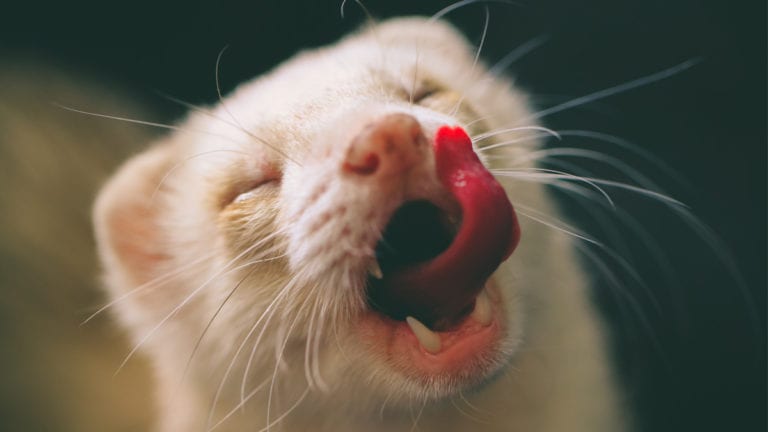On a gloomy mid-November day, the clock struck 5 p.m. — time for the ferrets to spin out of bed for playtime. I approached Chancey, a 5-year old female that lived alone in a two-story cage in my bedroom. She was napping on the second level. She had played hard that morning, eaten her snacks eagerly, and seemed fine when she went to bed at about 10 a.m. Now she looked at me from her sleep sack, groggy and uninterested in play. I opened the bottom door to her cage, and called her down. She moved toward the ramp very slowly.
Now, Chancey is a bit of a plump girl, with a definite waddle when she moves. But, I noticed she wasn’t really walking as she approached the ramp, and slid, rather than walked, down to the first floor, where she pulled herself toward me. When I lifted her out and set her on my bed (a favorite place for the chubby weasel that is simply too fat to get up there on her own!) she dragged herself by her front legs to the middle of the bed, and stopped. My mom, who saw the events unfold, immediately concluded that Chancey must have fallen and hurt herself — breaking her legs or her back.
This scenario is all too common among ferret owners. Veterinarians familiar with ferret medicine have to deal with this presentation of hind-end weakness on a daily basis. Ferrets are so active, so playful and always into so much trouble that injuries tend to be high on an owner’s list of concerns. But hind-end weakness is often a much more complicated scenario than just an injury, and usually takes some detective work on behalf of both the veterinarian and the ferret owner to “ferret out” the underlying problem. Hind-end weakness can be the result of a large variety of systemic (bodywide) diseases and conditions, as well as injuries.
What Could This Be?
One of the first differentiations that must be made is whether the ferret is experiencing “posterior paresis” (rear leg weakness) or “ataxia” (wobbliness due to neurologic disease). Sometimes, a veterinarian is able to do this simply on a physical examination, performing what is called a “neurologic examination.”
During this exam, your veterinarian will try to determine how much feeling the ferret has in its hind legs, whether the ferret can move them voluntarily, and if the ferret knows where the legs are in space (for example, will the ferret try to land on its feet when it sees it is being placed down onto a table?). On occasion, the results of these “placing” tests may be inconclusive, because a very weak ferret will be unable to place its feet properly, as will a ferret with neurologic disease. Weakness and neurologic disorders are caused by different diseases, however, so it is a useful distinction to make, when possible.
Another important distinction is whether the ferret is weak because of discomfort. Pain in the caudal part of the abdomen (the back part of the belly, near the hind legs) can result in what appears to be hind-end weakness. Conditions that cause caudal abdominal discomfort include an enlarged spleen (which may or may not be painful),
Basically, hind-end weakness can be due to a large variety of conditions and, in almost every instance, your veterinarian must run some tests in order to determine what is causing the problem, how serious it is and what can be done about it. Although those tests may be fine-tuned based on the information you can provide about your ferret (age, history, toxin and injury exposure, other problems like insulinoma), many veterinarians will start out with both radiographs (X-rays) and blood work.
Back to poor old Chancey on that fateful Saturday afternoon. Given the scenario that she was perfectly normal that morning with little opportunity for injury in her cage, I felt that an injury was not likely. However, back disorders such as intervertebral disc disease (a condition in which the cushioning between the vertebrae puts pressure on the spinal cord and causes pain and weakness) were still possible. So I took a radiograph, which showed all of her bones and vertebrae appeared normal. Chancey had a history of some kidney disease as well as an enlarged spleen, so I did a blood panel on her and looked at a urine sample. The X-ray showed that her spleen was still enlarged, and she had some changes in her lungs that also worried us. Blood panel results aren’t as immediate as X-rays, and I began to wonder what they might show.
How Do We Figure This All Out?
If it’s fairly certain that no likely fractures of the bones exist and no tumors are in the bones surrounding the spinal canal, and the cushions between the vertebrae look normal on radiographs, veterinarians often look next to the systemic cause of hind-end weakness, which is often evaluated through blood and urine tests. Certain conditions also may require more specialized testing, such as biopsies to look for cancer.
One of the first thoughts many ferret owners and veterinarians have when dealing with a problem such as this is insulinoma. Many ferrets experiencing either short-term hypoglycemia (low blood sugar) or long term hypoglycemia will show weakness in the hind legs. This may, or may not, be accompanied by other signs of insulinoma, such as seizures, weight loss and general lethargy.
Fortunately, low blood sugar is readily evaluated on a blood sample, and your veterinarian may request a short fast (three to four hours) before the test. Ferrets suspected of having an insulinoma should never be fasted for a prolonged period of time unless they are under a veterinarian’s care, as this may cause a drop in blood sugar and precipitate a seizure.
Other metabolic conditions, including liver disease, kidney disease, cancers (such as lymphoma), sepsis (generalized infections) proliferative bowel disease, may cause weakness. Many, but not all, of these systemic conditions will show up on routine blood panels.
Some conditions, such as lymphoma, might require special testing, including biopsies. Conditions affecting the heart, resulting in inadequate blood flow to the hind legs, can also result in weakness. Even something as simple as not eating well for a period of time can result in a weakness of the hind legs.
A critical consideration in any sick ferret, including those that are experiencing weakness in the hind legs, is toxin ingestion. Our little ferret friends are so inquisitive and tend to put everything into their mouth (just like babies).
Unfortunately, this can lead not only to ingestion of foreign bodies, but also toxins. Many, many toxins can cause hind-end weakness — so any potential ingestion of household chemicals or medication (including those like ibuprofen or acetaminophen) must be immediately reported to the veterinarian. The sooner a veterinarian knows about a potential poison, the better the chance of treating the condition before permanent or fatal damage occurs.
Are you starting to feel overwhelmed yet? Sorting out weakness in the ferret can be a complex and difficult task.
One other crucial factor to consider is Aleutian disease virus (ADV), a not-uncommon viral disease in the ferret population. Many infected ferrets can carry the virus for long periods of time — even years — without showing any signs of it. Over time, ADV slowly causes changes within the body, altering the immune system and changing many of the internal organs. Hind-end weakness is just one of the symptoms of ADV, and in some ferrets it may be the only sign.
There is only one way to know if your ferrets are infected with ADV, with a specific blood test. Every ferret that you own should be tested, before they show signs of disease. This is something that most veterinarians can do even at the time of the annual physical for your ferret. Remember, normal-appearing ferrets are not ADV free until they have a blood test proving their lack of infection. Because there is some variability in tests and test methodologies, some owners even elect to have their animals retested on an annual basis. You simply can’t be too careful.
Chancey’s Diagnosis
Back to little Chancey. Her ADV test came back negative (she had also had three or four previous negative tests). Her blood and urine tests showed that she had a severe kidney infection, and was developing sepsis (a bodywide infection of the bloodstream). She was immediately started on both injectable and oral antibiotics.
During the next 48 hours, her condition deteriorated. She developed some difficulty breathing, strained to produce stool, and the stools were very small and soft. In addition, her appetite worsened and she became depressed.
We repeated her X-rays and discovered that she had developed pneumonia in addition to proliferative colitis. Her medications were changed to new antibiotics as well as gastric protectants, she was also given pain medication and some anti-inflammatory drugs.
After a three-week battle, which at times was life or death, Chancey finally turned the corner. Although she sustained what is likely to be permanent additional kidney damage, and her stools are always going to be softer than usual, she is off medications, eating well and, best of all, able to war dance as well as her chubby body allows.
Chancey had several conditions, all of which may have caused her hind-end weakness — the kidney disease, the infection of the kidneys, the pneumonia, not eating well, the proliferative colitis and her obesity. Although we will never know what role each had to play in her weakness, if we hadn’t been thorough in looking for a cause, we might have lost Chancey. When she did not respond to the initial treatment, we were able to quickly re-evaluate her condition, re-test and change course.
Medicine is as much an art form as a science, and illnesses are often moving targets. Sometimes a very vague and non-specific sign — such as hind-end weakness — is an indication that a much larger process is at work. Veterinarians sometimes need a fairly extensive database to be able to assess that process in its entirety, and treat the condition as completely as possible.
Little Chancey still gets a midday Bob Church chicken gravy snack out of our cache of ferret supplies, and is as eager as ever to dance on the bed. Luckily, her hind-end weakness wasn’t due to a broken bone or broken back!
Posted By: Chewy Editorial
Featured Image: Via Carmelka/iStock/Thinkstock
Share:









